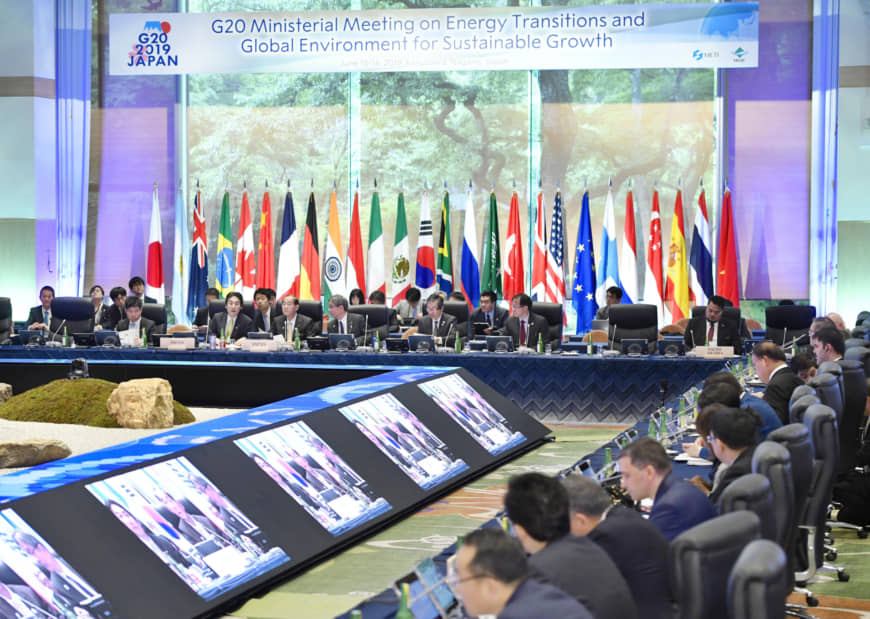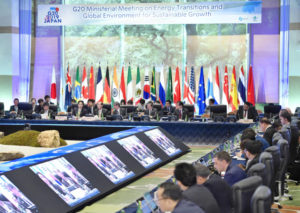The Nagano Prefecture resort town of Karuizawa has long been associated with green, natural energy. Nestled in the mountains, Karuizawa has lon
The Nagano Prefecture resort town of Karuizawa has long been associated with green, natural energy.
Nestled in the mountains, Karuizawa has long attracted both Japanese and Westerners escaping the capital’s heat to recharge their batteries in the verdant outdoors ever since the 19th century.
Recently, green energy has taken on a literal meaning, as Karuizawa and Nagano Prefecture seek to become environmental leaders.
By promoting long-term renewable energy targets for the mid-21st century, Karuizawa aims to do its part to meet the goal of the 2015 Paris agreement on climate change to limit the global temperature rise to 1.5 degrees Celsius by the end of the century.
At the Group of 20 environment and energy ministers meeting in Karuizawa last month, Nagano officials explained its long-term energy goal of increasing electricity generated by renewable energy — especially using solar power and hydropower.
“We set a goal in 2013 to reduce greenhouse gas emissions by 10 percent by fiscal 2020, 30 percent by fiscal 2030, and 80 percent by fiscal 2050 compared to greenhouse gas levels in 1990,” said Maseki Takashi, director of the prefecture’s sustainable energy policy division.
Nagano officials believe that one way to meet these goals is to promote solar rooftops throughout the prefecture. To encourage residents and businesses to install solar panels, Nagano created a database and interactive map that indicates buildings that have high potential to generate solar power efficiently.
Buildings labeled in red are optimal, as they provide the most solar potential, compared with yellow, which have moderate potential. The interactive map includes features that provide information on how much electricity could be generated if rooftop panels are installed, as well as how much carbon emissions could be reduced.
“There is also information on getting local government subsidies for installation costs,” Takashi says.
Under the 2013 strategy, Nagano businesses must submit three-year plans on how they will reduce greenhouse gases in their business area. Companies and households looking to build new structures must also consider energy-saving buildings that utilize renewable sources of energy.
Nagano retailers are also required to put energy efficiency labels on home appliances such as air conditioners, televisions and refrigerators, letting customers know how energy efficient they are.
Nagano is just one of a growing number of localities in Japan that are setting polices, goals and numerical targets to introduce renewables and reduce greenhouse gases that go further than the national government’s goals.
Japan’s local efforts are also part of a worldwide trend. Cities and states directly feel the negative social and economic effects of severe weather associated with climate change, and bear the burden of economic recovery after heavy flooding or droughts.
Local renewable energy and greenhouse gas reduction goals provide the basis for local economic, as well as environmental, priorities in the years ahead.
“There is a disconnect between Tokyo and local governments in terms of strong policies to introduce renewable energy and reduce greenhouse gas emissions,” says Kimiko Hirata, international director of Kiko Network, an environmental nongovernmental organization. “There is also a disconnect between the central government and environmentally minded companies. Since the 2015 Paris agreement, at least 20 companies have made a commitment to 100 percent renewable energy, and the number is growing.”
Why the disconnect?
Hirata says the national government’s decision-making on the country’s electricity mix has traditionally been heavily influenced by the 10 major utilities that operate most of Japan’s fossil fuel and nuclear power plants. On top of that, large industrial users of electricity — particularly steel firms — tend to prefer coal, oil and natural gas over renewable energy, due to its cost.
Collectively, these firms have long had a close relationship with lawmakers and the Ministry of Economy, Trade, and Industry, with corporate executives serving as advisers on various government committees and METI bureaucrats retiring to serve as steel industry advisers, a process known as amakudari.
“Many Japanese people, local governments and local businesses are ready to take action to reduce emissions and introduce renewable energy. But the national government policy isn’t supporting that level of enthusiasm, which is unfortunate.”
To be fair, the Japanese government did announce a new strategy just prior to the G20 environmental ministers summit to meet the Paris agreement. It calls for a decarbonized society as early is possible — but in the second half of this century. Tokyo also pledged to achieve an 80 percent reduction of GHG levels, based on 2010 levels — by 2050.
A 2018 report by the Intergovernmental Panel on Climate Change warned that limiting global warming to 1.5 degrees Celsius would require global net human-caused emissions of carbon dioxide to fall by about 45 percent from 2010 levels by 2030, reaching net zero around 2050.
While renewable energy is deemed a major power source, along with hydrogen energy, and although the creation of carbon-neutral communities by 2050 is stated as a major goal, the plan has come under domestic and international criticism for adhering to the use of coal.
It also promotes controversial carbon capture and storage technology, which remains technologically complex and expensive to implement — money that a growing number of local governments and companies do not have or want to spend if renewable energy is available at a competitive price.
Following Nagano’s lead, Fukushima Prefecture announced in 2014 it was aiming to have renewable energy meet 40 percent of its energy demand by 2020, two-thirds by 2030 and 100 percent by 2040.
And the city of Takaruzuka, Hyogo Prefecture, has set a goal of having renewable energy provide 100 percent of electricity to households, businesses and local industries by 2050.
More rural governments like Nagano are interested in setting strong GHG reduction targets or ambitious renewable energy targets. In May, mayors from 30 cities and metropolises from around the world, including Tokyo and Osaka, signed a commitment to achieving 100 percent renewable electricity by 2030, and 100 percent renewable energy by 2050.
At the Karuizawa meeting, much emphasis was placed on the importance of spurring technological, financial and management innovation to meet the goals of the Paris agreement, as well as the 2030 U.N. Sustainable Development Goals.
These were the best ways, the central government ministers stated, to meet the environmental challenges of this century. While the importance of international treaties like the Paris agreement was mentioned in passing, the national leaders did not want to go further lest no agreement, which must be made by consensus, be reached.
Yet the very hall the ministers were discussing the environment and the future of energy in was powered by renewable energy that day. At the booth on Nagano’s renewable energy efforts next to Karuizawa Station, a monitor, beside one providing updates on rooftop solar potential, kept track of how much renewable energy was being used at the Prince Hotel.
Continued innovation and the kinds of action at the local level could mean that, by the time the next G20 environment and energy ministers meeting is hosted by Japan in 2039, Karuizawa will be fully powered by renewables — and that Tokyo, Osaka and other localities around Japan won’t be that far behind.
japantimes.co.jp


